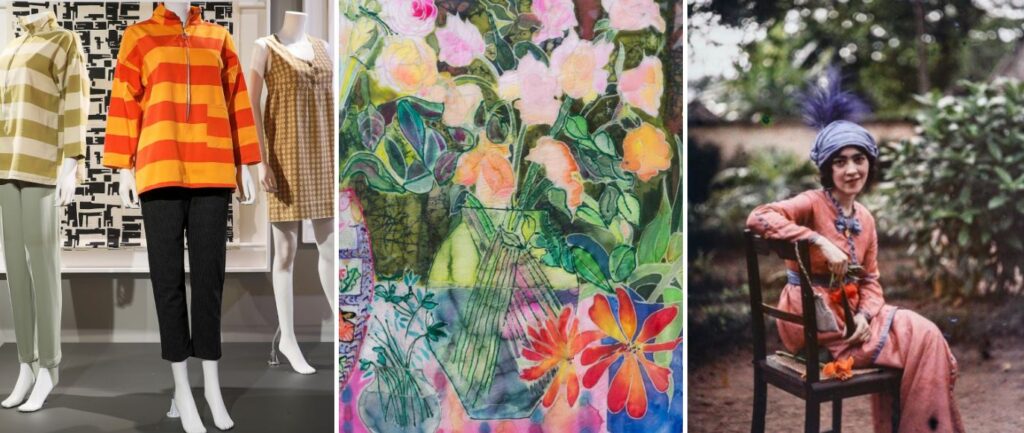
Located on London’s bustling Bermondsey Street, the Fashion and Textile Museum is still one of the city’s most unique cultural venues, both aesthetically and conceptually. With its recognizable color scheme of vivid pinks and burnt oranges, Ricardo Legorreta’s building serves as a striking visual representation of the kind of creative energy it encourages within. Since Dame Zandra Rhodes founded the museum in 2003, it has established a distinctive identity that is especially inventive in its dedication to changing the narratives of fashion and textiles.
Instead of holding a permanent collection, the museum features a regularly changing schedule of exhibitions that are particularly notable for their emphasis on various, international design voices. These exhibitions enable a continuous conversation that reflects the urgency, vitality, and transformation of fashion today by frequently showcasing underrepresented disciplines and voices. The current exhibition, Textiles: The Art of Mankind, for instance, looks at how people’s relationship with fibers has influenced architecture, technology, and even mobility. It looks at how rope once made it possible for trade, travel, and agriculture to flourish.
Fashion and Textile Museum – Essential Information
| Name | Fashion and Textile Museum |
|---|---|
| Location | 83 Bermondsey Street, London SE1 3XF, United Kingdom |
| Founded | 2003 |
| Founder | Dame Zandra Rhodes |
| Architect | Ricardo Legorreta |
| Managed By | Newham College of Further Education |
| Focus | Contemporary Fashion and Textile Design |
| Signature Exhibits | “Textiles: The Art of Mankind”, “Costume Couture” |
| Website | https://fashiontextilemuseum.org |
The museum functions without the limitations of a permanent exhibit, making it remarkably akin to a moving design studio: fluid, responsive, and constantly forward-looking. This flexibility has been especially helpful in drawing in new generations of tourists who value layered meaning and tactile experience over static chronology. The World of Anna Sui, Liberty in Fashion, and Knitwear: From Chanel to Westwood are a few examples of previous exhibitions that show how clothing changes over time to reflect cultural changes and individual identities.
Newham College has been running the Fashion and Textile Museum since 2007, and through engagement and education, it has greatly increased its reach. The museum has evolved into a community learning center that feels much more participatory than traditional institutions by providing workshops and experiential courses for students of all ages. Students might learn pattern cutting from Sarah Campbell one afternoon, and the following day, families are invited to participate in textile upcycling with artist Lynn Setterington. These are both socially conscious and creatively stimulating activities.
By means of strategic alliances and regularly selected programming, the museum has also improved its ability to make money from its location. Its mission is supported by event rentals, retail sales, and educational reservations, all of which enable it to keep a flexible schedule while maintaining accessibility. It’s particularly noteworthy how the gift shop, which is frequently overlooked in similar settings, provides a surprisingly wide selection of reasonably priced books and accessories that help visitors live out the exhibit’s message.
The museum has adopted sustainability over the last ten years—not as a fad, but as a fundamental idea. The art of mending, repurposing, and sustainable dyeing has been emphasized by exhibitions like Reuse, Reduce, Recycle, and Full Circle, which have made discussions feel much more pertinent in light of the environmental costs associated with fast fashion. As a result, the museum has become a hub for designers and shoppers who want to reimagine fashion’s future via thoughtful craftsmanship and consumption.
Costume Couture: Sixty Years of Cosprop, which opens in September 2025, will highlight the museum’s connection to film. The exhibit combines fashion and storytelling in a nostalgic and masterfully curated way by presenting period costumes from Downton Abbey, Peaky Blinders, and other classic productions. The exhibit promises to delve into the transformative nature of costume in tactile detail, as encapsulated in Helena Bonham Carter‘s quote, “We entered Cosprop as ourselves and walked out as the person we were playing.”
The museum’s cultural impact is far greater than its modest size would suggest. In order to increase the accessibility of its work, it regularly lends its exhibitions both domestically and internationally, working with international organizations. Through careful curation and logistical preparation, this outreach helps the museum maintain its close-knit, intimate culture while increasing its impact.
Beautiful People: The Boutique in 1960s Counterculture, one especially noteworthy exhibition, examined how retail establishments evolved into countercultural laboratories of identity and style during a pivotal period in British history. These kinds of exhibits are incredibly durable in their ability to document changes in politics, gender expression, and urban identity, and they transcend mere aesthetic appreciation.
The public’s reaction has always been positive. The museum’s welcoming staff, engaging exhibits, and compact size, which permits contemplation without becoming weary, are frequently praised by visitors. The overwhelming positive feedback shows how much visitors value carefully chosen depth over scale, even though some critics have criticized some exhibits for being too brief. Rather than feeling overwhelming, spending a little more than two hours here frequently feels incredibly enriching.
The museum’s programming that focuses on the future is arguably the most inspiring. It intends to strengthen its sustainability alliances, increase accessibility, and broaden its digital offerings. The museum is remarkably successful at staying up to date, balancing innovation and heritage in a way that is both approachable and educational, even though its exhibitions are frequently planned years in advance.
The Fashion and Textile Museum animates fashion rather than merely documenting it. It serves as a workshop, a classroom, and a launchpad in addition to being an archive. It keeps changing the way that fashion is perceived—not just as apparel, but also as culture, movement, and memory—by honoring the hands that sew, the brains that design, and the voices that criticize.
